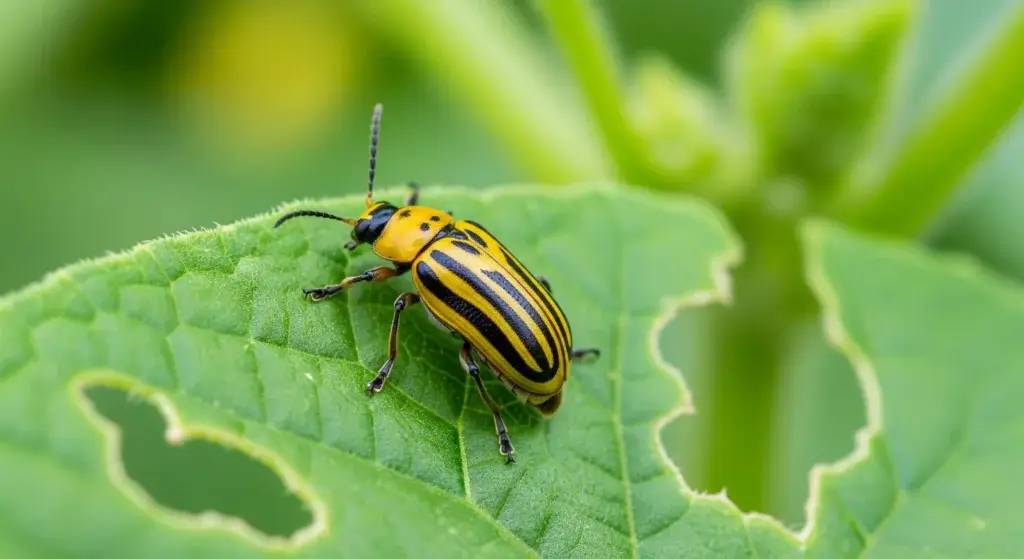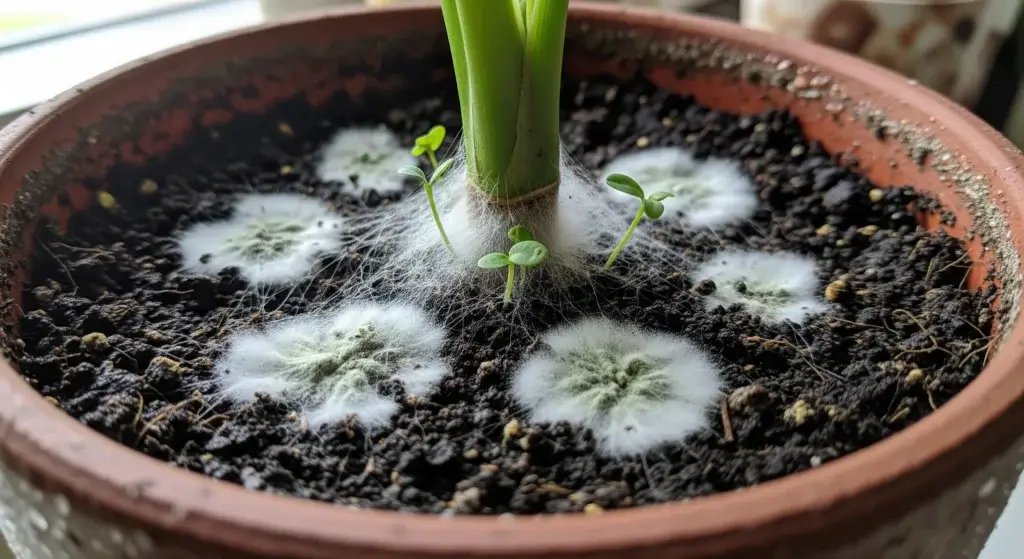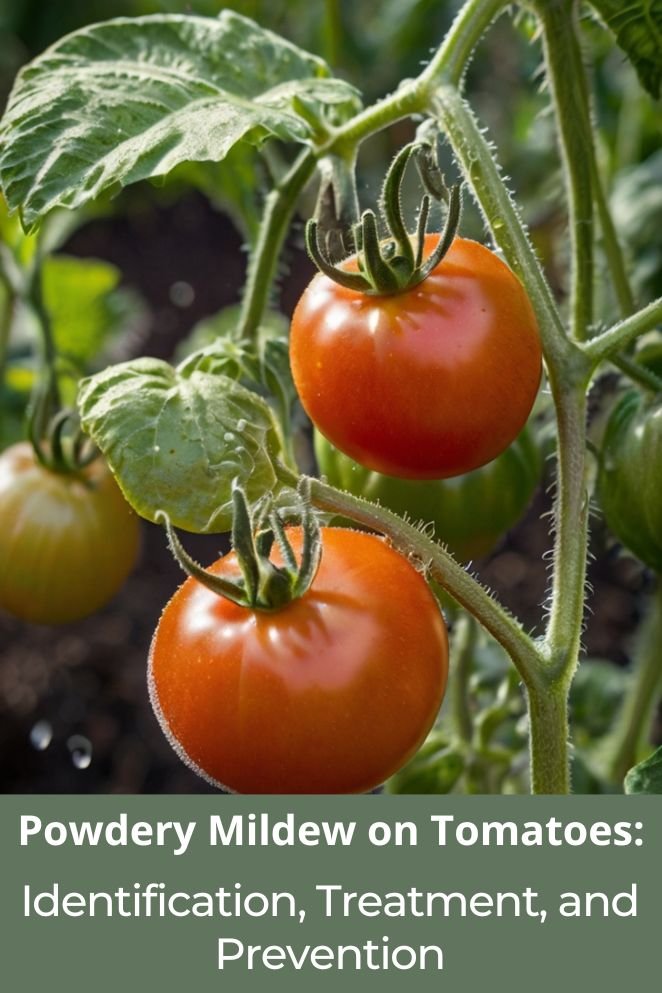
If you’ve ever spotted white, dusty patches on your tomato leaves and felt personally attacked—yeah, that’s powdery mildew.
It’s one of the most annoying fungal party crashers in both backyard gardens and big-time farms.
But don’t panic! This guide shows you how to spot it fast, kick it to the curb, and stop it from coming back—so your tomatoes can live their best, juicy lives all season long.
Identifying Powdery Mildew on Tomato Plants
Visual symptoms
So you’re out admiring your tomato jungle, and—ugh—you see weird white patches on the leaves?
Bad news: powdery mildew might’ve RSVP’d to your garden party.
Here’s what to look for:
- White or grayish spots on the tops of older leaves (they look like someone dusted them with flour—rude).
- Those spots get bigger and fuzzier until your whole leaf’s a powdery mess.
- Yellowing, browning, and early leaf drop (starts from the bottom up, like the world’s worst fashion trend).
- Slower growth, sad fruit production, and in bad cases—curled, twisted leaves.
Where to look
Start with the older, lower leaves.
That’s where powdery mildew loves to sneak in first.
Flip the leaves and look underneath—fungus loves to lurk in the shadows like it’s plotting something.
And if you find it on one plant, check its neighbors ASAP. These spores travel by air faster than spoilers after a new Marvel drop.
- Read also: Growing Healthy: A Guide to Natural Pesticides for Tomatoes
- Read also: Effective Strategies for Getting Rid of Tomato Hornworms
Distinguishing from other diseases
- Downy mildew = yellow spots on top, fuzzy stuff underneath.
- Bacterial speck = dark dots with yellow halos (looks like the tomato caught a cold).
- Early blight = dark rings like a target symbol—definitely different vibes.
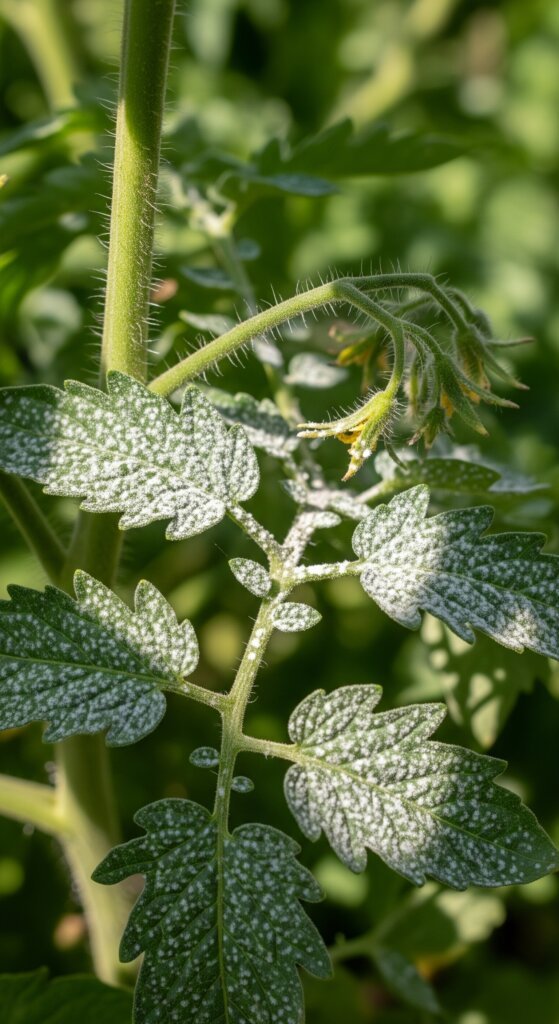
Causes and Risk Factors
Powdery mildew doesn’t just show up for fun—it’s got a whole checklist of conditions it loves.
If your tomato plants are stressed, crowded, or chilling in the wrong kind of weather, the fungus sees that as an open invite.
Environmental conditions
- Temps between 60–80°F (15–27°C) — basically that “perfect spring day” sweet spot… for mildew.
- High humidity + dry leaf surfaces — yep, the combo of moist air but dry leaves is mildew heaven.
- No air flow = fungus lounge zone — still air around your plants is like giving the mildew a massage chair.
- Too much shade — mildew’s shady like that. It thrives when your plant doesn’t get enough direct sun.
- Overcrowding — tight tomato setups = little fungal Airbnb spots between leaves.
Plant stress factors
Just like us, stressed-out tomatoes are more likely to get sick.
Here’s what pushes them over the edge:
- Water drama: Too much or too little = instant vulnerability. Tomatoes like consistency, not chaos.
- Nutrient mess-ups: Extra nitrogen? Weak growth. Low potassium? Poor defense system. Balance is everything.
- Root trauma: Rough digging, pest attacks, or anything that messes with their underground life stresses them out.
- Heavy fruit loads: If your plant’s pumping out tomatoes like it’s in a competition, it might weaken overall immunity.
Effective Treatment Options
Okay, so you’ve spotted the dreaded white fuzz. Don’t panic!
There are plenty of ways to kick powdery mildew off your tomato plants like it’s overstayed its welcome at the garden party.
From DIY sprays to pro-level fungicides, we’ve got options.
Organic and natural treatments
Baking soda spray
Old-school but effective.
Mix 3 tablespoons of baking soda in 1 gallon of water, add a splash of liquid soap (not detergent, you’re not washing dishes), and spray away every 7–10 days.
Heads up: Don’t overdo it—too much baking soda can mess with your soil’s pH and turn it into a plant-unfriendly spa.
Milk spray solution
Yes, actual milk. Mix 1 part milk to 2 parts water and spritz your plants before mildew shows up.
It’s weird science, but the proteins in milk + sunlight = a fungus-fighting combo that works like a charm.
Also makes you feel like a tomato barista.
Neem oil treatment
This is the multitasker of the plant world.
Mix 2 tablespoons neem oil with a gallon of water + a few drops of soap. Spray every 7–14 days.
Neem basically messes with mildew’s life plan—no spores, no spread.
Pro tip: Cover both sides of the leaves. Powdery mildew is sneaky like that.
Commercial fungicides
Sulfur-based products
Old-school and super effective, but only if it’s not hotter than 85°F (29°C)—otherwise your leaves will crisp up like chips.
Follow the label, wear gloves, and maybe feel a little like a mad scientist in the garden.
Copper-based fungicides
Copper is like the fungal dream-crusher. Use it preventively and pair it with good airflow and spacing.
It won’t fix bad gardening habits, but it’ll help keep the mildew in check.
Potassium bicarbonate
Think of this as the chill cousin of baking soda—it fights mildew without messing up your soil’s vibes.
Regular use = solid protection with less pH drama.
Application tips for all treatments
- Timing: Spray early morning or late evening—no leaf sunburns, please.
- Coverage: Hit every nook and cranny—top, bottom, sides. If you’re not thorough, mildew will find its moment.
- Switch it up: Rotate treatments weekly. Don’t let the fungus build resistance like it’s training for a villain arc.
- Weather check: No spraying if it’s windy or if rain is in the forecast (aka don’t waste your magic potion).
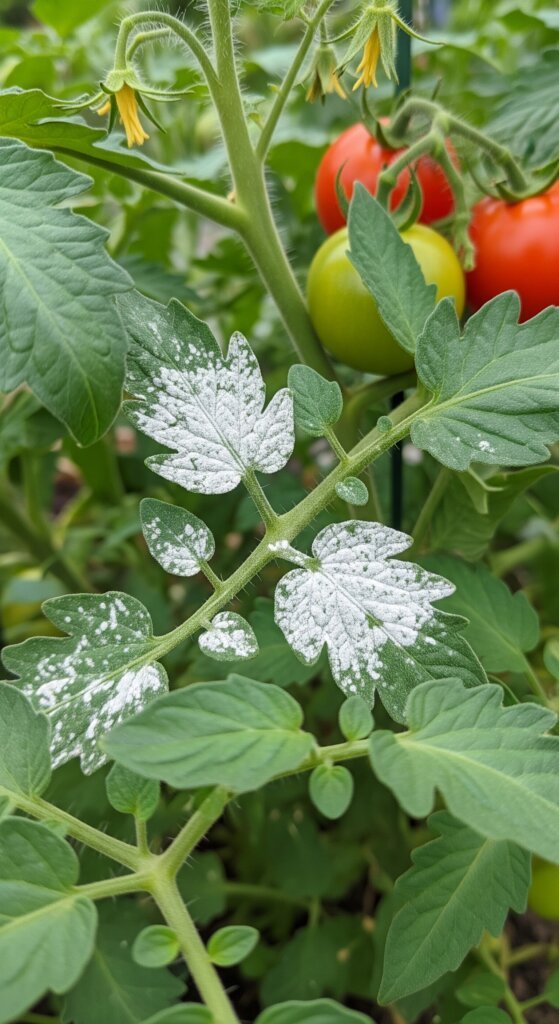
Prevention Strategies
Want to keep powdery mildew off your tomato plants for good? Prevention is the real MVP.
Treat your tomatoes like the stars they are—with space, airflow, hydration, and a little VIP security (aka resistant varieties).
Here’s how to keep your tomato patch drama-free and fungus-resistant:
Cultural practices
Proper plant spacing
Tomatoes need elbow room. Cramming them together = instant mildew hotspot.
- Plant spacing: Keep 18–24 inches between plants, 3–4 feet between rows.
- Why? Airflow, baby! Stale, humid air is basically a spa day for fungus.
Watering techniques
Moisture is important—but too much in the wrong place? That’s mildew’s love language.
- Water at the base: Use drip irrigation or a soaker hose. Keep those leaves dry—no surprise showers.
- Water early: Morning is ideal. That way, anything that does get wet can dry out before nightfall.
- Say no to sprinklers: Overhead watering = wet leaves = mildew’s big break.
- Stay consistent: Don’t let the soil dry out completely or stay soggy. Tomatoes want Goldilocks moisture—just right.
Pruning and maintenance
Thinning out your plant not only keeps it looking fresh, it helps fight disease.
- Remove lower leaves: Especially the ones that touch the soil. They’re basically mildew magnets.
- Open up the canopy: Prune inner branches so air can move through. Think of it as giving your plant breathable fabric.
- Snip and toss infected parts: Don’t compost them—trash them like bad vibes.
- Clean your tools: Wipe down pruners between plants. This isn’t a plant plague tour.
Site selection and soil management
Choose the right location
Where you grow matters just as much as how.
- Sunlight: 6–8 hours of direct sunlight = strong, happy plants
- Drainage: No puddles. Tomatoes don’t want wet feet.
- Air movement: Skip cramped corners. Think “wind-friendly.”
- Soil vibes: Loose, fertile, and slightly acidic (pH 6.0–6.8) is tomato heaven.
Soil health practices
Healthy soil = stronger plants = less fungal drama.
- Compost it up: Add organic matter to keep roots chill and microbes happy.
- Fertilize smart: Too much nitrogen = lush leaves + weak defense. Go balanced.
- Mulch: Helps with moisture, stress, and keeps soil splash to a minimum.
- Rotate your crops: Don’t plant tomatoes in the same spot every year. Give the soil a break from the solanaceae fam.
Resistant varieties
Some tomatoes are just built different.
Go for varieties that have “PM” resistance on the label—that’s powdery mildew shorthand.
Top tomato fighters:
- Celebrity: Chill, determinate, and tough as nails.
- Mountain pride: Strong mildew tolerance and great flavor.
- Iron lady: The name says it all—indeterminate and ready to throw hands.
- Defiant PhR: Literally bred to resist powdery mildew.
- Phoenix: Heat + disease resistant. Like your tomato garden’s bodyguard.

Advanced Management Techniques
Integrated Pest Management (IPM)
This isn’t just spraying and praying.
IPM is about using multiple smart moves together to stop mildew before it even thinks about showing up.
- Monitoring: Walk your garden regularly and catch mildew early before it spreads like spoilers after a season finale.
- Cultural controls: hat’s all the spacing, watering, pruning, and sanitation you’ve already nailed.
- Biological controls: Use good microbes (yes, friendly fungi and bacteria) to out-compete the bad guys.
- Chemical controls: Only when needed, and only the targeted kind. No need to go full apocalypse mode.
Innovative approaches
UV light treatment
Researchers are using UV-B and UV-C light like lightsabers against mildew—and it works! Especially in greenhouses.
It’s not quite Iron Man tech, but pretty close. If you’ve got a controlled setup, this could be a game-changer.
Beneficial microorganisms
Let the microbes do the dirty work.
Products with Bacillus subtilis or Trichoderma species basically throw mildew off its game by taking up space and nutrients first.
Think of them as your plant’s microscopic bodyguards.
Companion planting
Turns out, your tomatoes like good neighbors.
Try growing these sidekicks nearby to help reduce stress and possibly even fend off mildew:
- Basil – Not just for your caprese. It might have mild antifungal powers.
- Marigolds – Great for overall garden vibes and pest control.
- Garlic – Strong smell, strong defense. May help with fungal resistance.
- Chives – Cute, useful, and possibly good at keeping stressy bugs away.
Common Mistakes to Avoid
Even the best plant parents slip up sometimes.
But if you want to keep your tomatoes thriving and mildew-free, avoid these common tomato crimes:
Overwatering
Tomatoes love moisture, but not a swamp.
Water deeply, but let the top of the soil dry out a bit between drinks.
Think “hydrated, not clingy.” Constant sogginess just screams “hey fungus, come party here!”
Ignoring early symptoms
See a little white fuzz? That’s your cue to act now, not next weekend.
Powdery mildew is like a bad ex—it spreads fast if you don’t shut it down early.
Don’t wait for a full-blown outbreak to get serious.
Poor air circulation
I know packing plants in tight looks lush for the ’Gram, but tomatoes hate crowding.
They need breathing room. No space = no airflow = mildew moves in like it pays rent.
Inconsistent treatment
Spraying once and forgetting about it? Nah. Treatments work only if you stay consistent.
Set reminders. Make a chart. Name your sprayer if it helps.
Just stick to the schedule like it’s your favorite show’s release day.
Wrong timing
High noon + leaf spray = crispy tomato drama.
Apply treatments early morning or after the sun chills out in the evening.
Your plants will thank you with happy, mildew-free leaves.
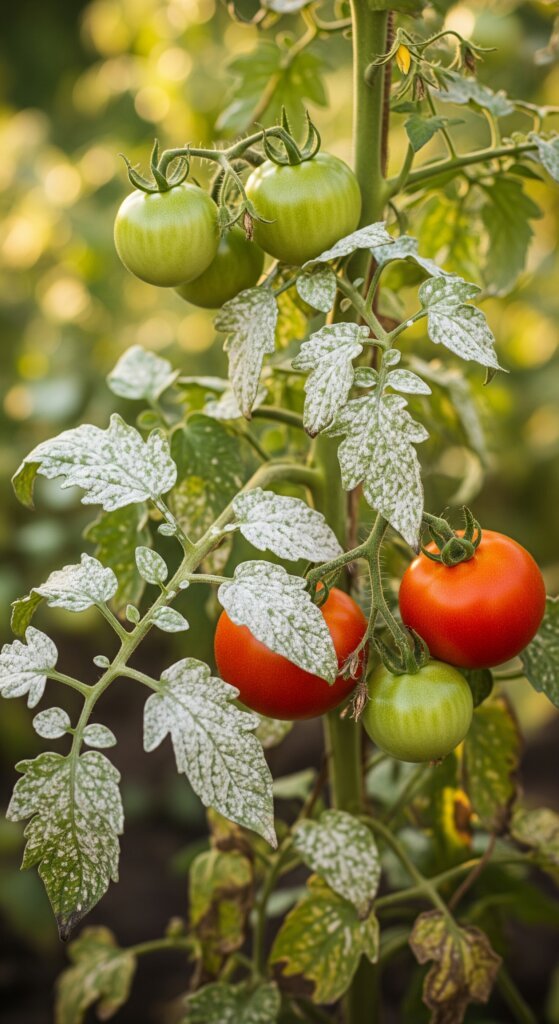
- Read also: Beat the Blight: Common Fungal Diseases of Tomatoes
- Read also: A Comprehensive Guide: Controlling Bacterial Spot on Tomatoes
Final Word: Beat Powdery Mildew Like a Pro
Powdery mildew’s annoying, but it’s totally beatable if you stay on top of it.
The secret? Catch it early, treat it consistently, and don’t skip the basics—like airflow, spacing, and choosing resistant varieties.
It’s not a “set it and forget it” deal—think of it more like skincare for your tomatoes.
A little attention goes a long way toward juicy, healthy fruit and zero fungal drama.


